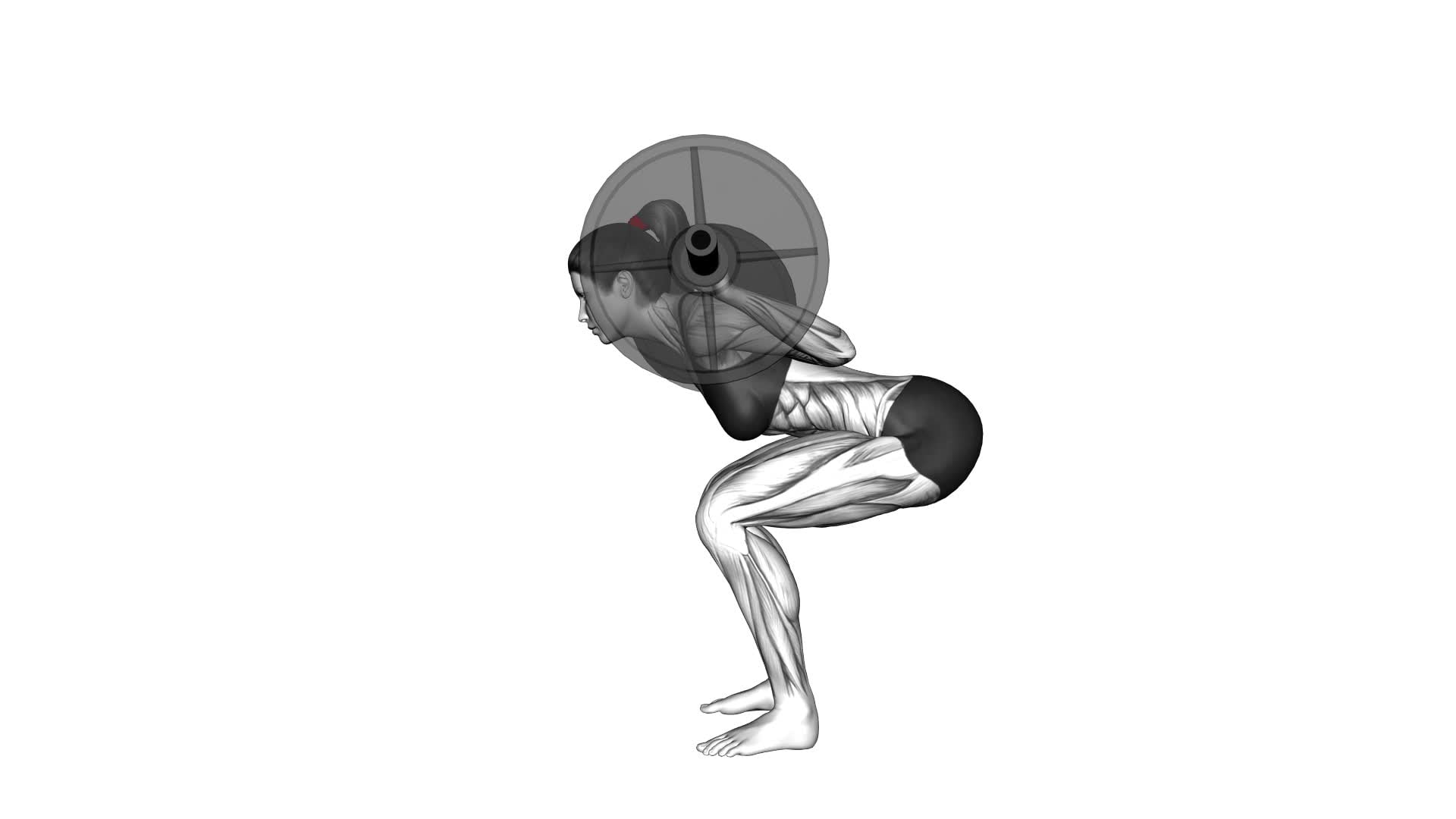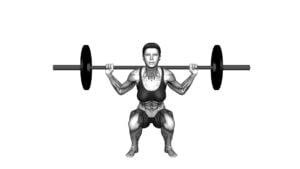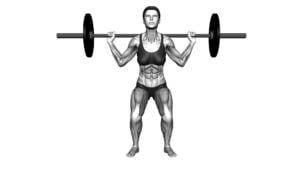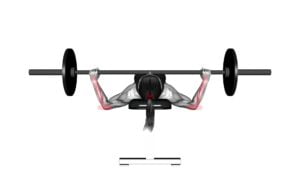Barbell Squat – Hips (WRONG RIGHT) (female) – Video Exercise Guide & Tips

Are you struggling with your hip alignment during barbell squats? Don't worry, we've got you covered.
Watch This Exercise Video
In this video exercise guide, we will show you the common mistakes to avoid and provide tips for proper hip placement.
Specifically designed for females, we will address the adjustments needed for a successful barbell squat.
Watch our video guide to learn how to correct your hip position and maintain stability throughout the exercise.
Get ready to improve your barbell squat form and maximize your gains.
Key Takeaways
- Lack of hip mobility can lead to pain and decreased performance
- Proper hip alignment is crucial for optimal performance and reducing the risk of injury
- Adequate hip mobility allows for a full range of motion during the squat
- Maintaining hip stability through targeted exercises and proper technique is important for preventing strain and optimizing performance
Common Mistakes With Hips in Barbell Squat
Avoid these common mistakes with your hip positioning during the barbell squat to maximize the benefits of this exercise. Proper hip mobility and activation are crucial for maintaining proper form and preventing injury.
One common mistake isn't having enough hip mobility. Limited hip mobility can lead to compensations in other areas of the body, such as the lower back or knees, which can result in pain and decreased performance. To improve hip mobility, incorporate exercises like hip flexor stretches, glute bridges, and deep squats into your warm-up routine. These exercises will help increase the range of motion in your hips, allowing for a deeper squat and better overall form.
Another mistake isn't activating the hips properly during the squat. Strong hip activation is essential for generating power and stability during the movement. To activate your hips, focus on squeezing your glutes and engaging your core as you descend into the squat. This will help maintain proper alignment and prevent your hips from collapsing inward or outward.
Proper Hip Alignment for Barbell Squat
To achieve proper hip alignment during the barbell squat, focus on maintaining a neutral position as you descend into the movement. Proper hip alignment is crucial for ensuring optimal performance and reducing the risk of injury. One way to improve hip alignment is by incorporating hip mobility exercises into your training routine. These exercises help to increase the range of motion in your hip joints, allowing for better movement during the squat. Some examples of hip mobility exercises include hip circles, hip flexor stretches, and lateral leg swings. By regularly performing these exercises, you can improve your hip mobility and ultimately achieve better hip alignment during the barbell squat.
There are several benefits of proper hip alignment during the barbell squat. Firstly, it helps to distribute the weight evenly across your hips and legs, preventing excessive stress on any one area. This can help to reduce the risk of strain or injury to the hips, knees, and lower back. Additionally, proper hip alignment allows for a deeper squat, which can target the muscles in your glutes, hamstrings, and quadriceps more effectively. This leads to greater muscle activation and overall strength gains.
Adjusting Hip Position for Female Barbell Squat
Maintain proper hip alignment by adjusting your position for the female barbell squat. Hip mobility and flexibility are crucial for performing this exercise correctly. To ensure optimal hip placement, start by standing with your feet shoulder-width apart and toes pointing slightly outward. As you lower into the squat, focus on pushing your hips back and down, keeping your knees in line with your toes. Avoid letting your knees cave inward or extend beyond your toes, as this can put unnecessary strain on your hips and knees.
To improve hip mobility and flexibility, incorporate exercises such as hip stretches, hip openers, and hip mobility drills into your warm-up routine. These exercises will help increase your range of motion and allow for better hip alignment during the barbell squat.
In the next section, we'll provide a video guide on correcting hip placement in the barbell squat. This visual demonstration will further assist you in understanding the proper technique and positioning for your hips. By following the tips and techniques outlined in the video guide, you can optimize your squat form and reduce the risk of injury.
Video Guide: Correcting Hip Placement in Barbell Squat
To improve your hip placement in the barbell squat, focus on maintaining proper form and alignment throughout the exercise. Correct hip placement is crucial for maximizing the effectiveness of your squat and preventing injury.
Two key factors to consider are hip mobility and hip activation.
Firstly, hip mobility plays a significant role in achieving the correct hip placement during the barbell squat. Adequate mobility allows for a full range of motion in the hips, enabling you to squat deeper and with better form. To improve hip mobility, incorporate exercises such as hip flexor stretches, glute bridges, and hip rotations into your warm-up routine. These exercises will help loosen tight muscles and increase the flexibility of your hips.
Secondly, hip activation is essential for maintaining stability and balance throughout the squat. Strong hip muscles, including the glutes and hip abductors, are necessary for proper hip placement. Engaging these muscles before and during the squat will help support your body and prevent your hips from collapsing inward. Incorporate exercises like clamshells, lateral leg raises, and glute bridges into your warm-up to activate the hip muscles.
Tips for Maintaining Hip Stability in Barbell Squat
To maintain stability in your hips during the barbell squat, focus on engaging your core muscles and keeping your knees aligned with your toes. This will help ensure proper form and prevent any unnecessary strain on your hips. Here are some tips for maintaining hip stability:
- Improve hip mobility: Incorporate exercises that specifically target hip mobility into your routine. This could include hip stretches, hip openers, or mobility drills. By increasing the range of motion in your hips, you'll be better able to perform the barbell squat with stability.
- Strengthen hip muscles: In addition to improving mobility, it's important to strengthen the muscles around your hips. Exercises such as hip thrusts, glute bridges, and lateral band walks can help target and strengthen the hip muscles, providing a solid foundation for hip stability during the barbell squat.
- Use proper technique: Pay attention to your form during the barbell squat. Ensure that your knees are tracking in line with your toes and that your core is engaged throughout the movement. This will help maintain stability in your hips and prevent any excessive sway or wobbling.
Frequently Asked Questions
What Are Some Common Mistakes to Avoid When It Comes to Hip Placement in Barbell Squats?
When it comes to hip placement in barbell squats, there are some common mistakes you should avoid. Proper hip alignment is crucial for a successful squat.
Some mistakes include letting your hips shift forward or backward, which can lead to poor form and potential injuries. Another mistake isn't keeping your hips parallel to the ground, which can cause imbalance.
Remember to engage your core and focus on keeping your hips in line with your knees throughout the exercise.
How Should I Properly Align My Hips During a Barbell Squat?
To properly align your hips during a barbell squat, avoid common mistakes in hip placement.
Make sure your feet are shoulder-width apart and toes slightly turned out. Engage your core and keep your chest up.
As you squat down, push your hips back and lower yourself until your thighs are parallel to the ground. Remember to maintain a neutral spine throughout the movement.
This proper hip alignment will help you perform the barbell squat safely and effectively.
Are There Any Specific Adjustments That Females Should Make to Their Hip Position During a Barbell Squat?
When it comes to barbell squats, women should pay attention to their hip position. Properly aligning your hips is important for maintaining good form and preventing injury.
Making adjustments to your hip position, such as keeping them in line with your knees and maintaining a neutral spine, can help you engage the correct muscles and get the most out of your workout.
Is There a Video Guide Available That Demonstrates How to Correct Hip Placement in Barbell Squats?
To correct your hip placement during barbell squats, it's important to maintain proper hip alignment. This ensures a safe and effective workout. Luckily, there's a video guide available that demonstrates the correct technique.
What Are Some Additional Tips for Maintaining Hip Stability During Barbell Squats?
To maintain hip stability during barbell squats, there are a few additional tips to keep in mind.
Firstly, incorporating hip stability exercises into your routine can help strengthen the muscles surrounding the hips.
Secondly, it's important to focus on developing a strong core, as this plays a crucial role in maintaining stability during squats. Remember to engage your core and keep your hips aligned throughout the movement.
These tips will help you maintain proper form and avoid any unnecessary strain on your hips.
Conclusion
In conclusion, proper hip alignment is crucial when performing the barbell squat exercise. It's important to avoid common mistakes and adjust the hip position accordingly, especially for female athletes.
By watching the video guide and following the tips provided, individuals can maintain hip stability and maximize the benefits of the barbell squat. Remember to prioritize correct form to prevent injuries and improve overall strength and fitness.

Author
Years ago, the spark of my life’s passion ignited in my mind the moment I stepped into the local gym for the first time. The inaugural bead of perspiration, the initial endeavor, the very first surge of endorphins, and a sense of pride that washed over me post-workout marked the beginning of my deep-seated interest in strength sports, fitness, and sports nutrition. This very curiosity blossomed rapidly into a profound fascination, propelling me to earn a Master’s degree in Physical Education from the Academy of Physical Education in Krakow, followed by a Sports Manager diploma from the Jagiellonian University. My journey of growth led me to gain more specialized qualifications, such as being a certified personal trainer with a focus on sports dietetics, a lifeguard, and an instructor for wellness and corrective gymnastics. Theoretical knowledge paired seamlessly with practical experience, reinforcing my belief that the transformation of individuals under my guidance was also a reflection of my personal growth. This belief holds true even today. Each day, I strive to push the boundaries and explore new realms. These realms gently elevate me to greater heights. The unique combination of passion for my field and the continuous quest for growth fuels my drive to break new ground.







